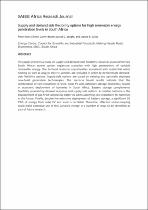 ResearchSpace
ResearchSpace
Supply and demand side flexibility options for high renewable energy penetration levels in South Africa
JavaScript is disabled for your browser. Some features of this site may not work without it.
- ResearchSpace
- →
- Research Publications/Outputs
- →
- Journal Articles
- →
- View Item
| dc.contributor.author |
Klein, Peter

|
|
| dc.contributor.author |
Carter-Brown, Clinton

|
|
| dc.contributor.author |
Wright, Jarrad G

|
|
| dc.contributor.author |
Calitz, Joanne R

|
|
| dc.date.accessioned | 2019-08-14T07:13:47Z | |
| dc.date.available | 2019-08-14T07:13:47Z | |
| dc.date.issued | 2019-09 | |
| dc.identifier.citation | Klein, P., Carter-Brown, C., Wright, J.G. and Calitz, J.R. 2019. Supply and demand side flexibility options for high renewable energy penetration levels in South Africa: In SAIEE Africa Research Journal, vol. 110(3), pp. 111-124. Doi: 10.23919/SAIEE.2019.8732763 | en_US |
| dc.identifier.issn | 1991-1696 | |
| dc.identifier.issn | 0038-2221 | |
| dc.identifier.uri | https://ieeexplore.ieee.org/document/8732763 | |
| dc.identifier.uri | https://ieeexplore.ieee.org/xpl/tocresult.jsp?isnumber=8732757&punumber=8475037 | |
| dc.identifier.uri | DOI: 10.23919/SAIEE.2019.8732763 | |
| dc.identifier.uri | http://hdl.handle.net/10204/11085 | |
| dc.description | Copyright: 2019 SAIEE. Due to copyright restrictions, the attached PDF file only contains the abstract version of the full-text item. For access to the full-text item, please consult the publisher's website. The definitive version of the work is published in SAIEE Africa Research Journal, vol. 110(3), pp. 111-124. Doi: 10.23919/SAIEE.2019.8732763 | en_US |
| dc.description.abstract | This paper presents a study on supply and demand side flexibility resources assessed for two South African power system expansion scenarios with high penetrations of variable renewable energy. The demand response opportunities associated with residential water heating as well as plug-in electric vehicles are included in order to demonstrate demand-side flexibility options. Supply-side options are based on existing and optimally deployed new-build generation technologies. The scenario based results indicate that the combination of cost reductions in wind, solar PV and stationary storage (batteries), results in economic deployment of batteries in South Africa. Battery storage complements flexibility provided by demand response and supply-side options. A notable outcome is the displacement of gas-fired turbines by batteries when assuming cost reductions for batteries in the future. Finally, despite the extensive deployment of battery storage, a significant 55 TWh of energy from solar PV and wind is curtailed. Therefore, effective sector-coupling could make extensive use of this curtailed energy in a number of ways to be identified as part of future research. | en_US |
| dc.language.iso | en | en_US |
| dc.publisher | SAIEE | en_US |
| dc.relation.ispartofseries | Workflow;22458 | |
| dc.subject | Coupling | en_US |
| dc.subject | Demand Response | en_US |
| dc.subject | Energy Sector | en_US |
| dc.subject | Energy Storage | en_US |
| dc.subject | Electric Vehicles | en_US |
| dc.subject | Integrated Resource Planning | en_US |
| dc.title | Supply and demand side flexibility options for high renewable energy penetration levels in South Africa | en_US |
| dc.type | Article | en_US |
| dc.identifier.apacitation | Klein, P., Carter-Brown, C., Wright, J. G., & Calitz, J. R. (2019). Supply and demand side flexibility options for high renewable energy penetration levels in South Africa. http://hdl.handle.net/10204/11085 | en_ZA |
| dc.identifier.chicagocitation | Klein, Peter, Clinton Carter-Brown, Jarrad G Wright, and Joanne R Calitz "Supply and demand side flexibility options for high renewable energy penetration levels in South Africa." (2019) http://hdl.handle.net/10204/11085 | en_ZA |
| dc.identifier.vancouvercitation | Klein P, Carter-Brown C, Wright JG, Calitz JR. Supply and demand side flexibility options for high renewable energy penetration levels in South Africa. 2019; http://hdl.handle.net/10204/11085. | en_ZA |
| dc.identifier.ris | TY - Article AU - Klein, Peter AU - Carter-Brown, Clinton AU - Wright, Jarrad G AU - Calitz, Joanne R AB - This paper presents a study on supply and demand side flexibility resources assessed for two South African power system expansion scenarios with high penetrations of variable renewable energy. The demand response opportunities associated with residential water heating as well as plug-in electric vehicles are included in order to demonstrate demand-side flexibility options. Supply-side options are based on existing and optimally deployed new-build generation technologies. The scenario based results indicate that the combination of cost reductions in wind, solar PV and stationary storage (batteries), results in economic deployment of batteries in South Africa. Battery storage complements flexibility provided by demand response and supply-side options. A notable outcome is the displacement of gas-fired turbines by batteries when assuming cost reductions for batteries in the future. Finally, despite the extensive deployment of battery storage, a significant 55 TWh of energy from solar PV and wind is curtailed. Therefore, effective sector-coupling could make extensive use of this curtailed energy in a number of ways to be identified as part of future research. DA - 2019-09 DB - ResearchSpace DP - CSIR KW - Coupling KW - Demand Response KW - Energy Sector KW - Energy Storage KW - Electric Vehicles KW - Integrated Resource Planning LK - https://researchspace.csir.co.za PY - 2019 SM - 1991-1696 SM - 0038-2221 T1 - Supply and demand side flexibility options for high renewable energy penetration levels in South Africa TI - Supply and demand side flexibility options for high renewable energy penetration levels in South Africa UR - http://hdl.handle.net/10204/11085 ER - | en_ZA |





